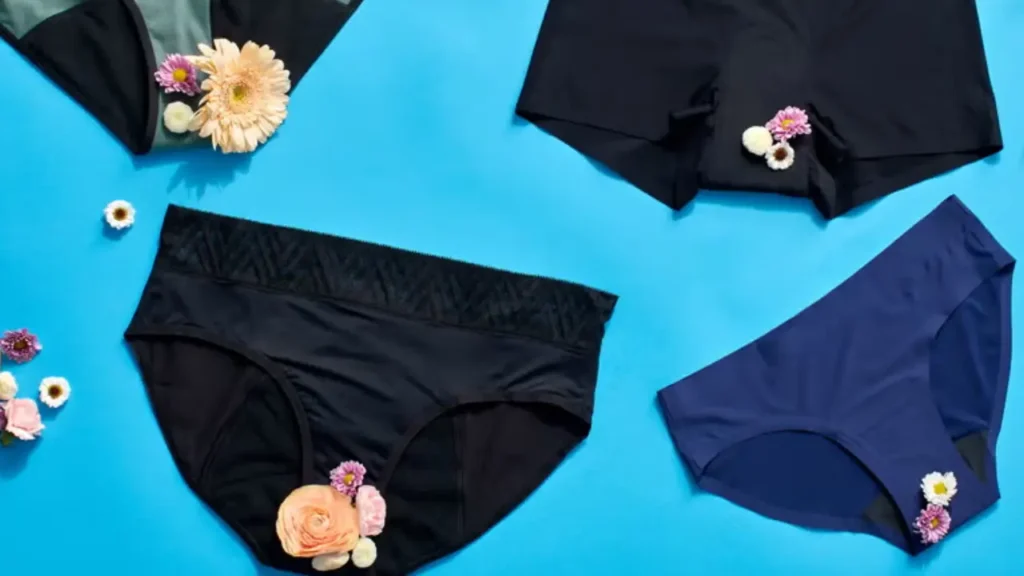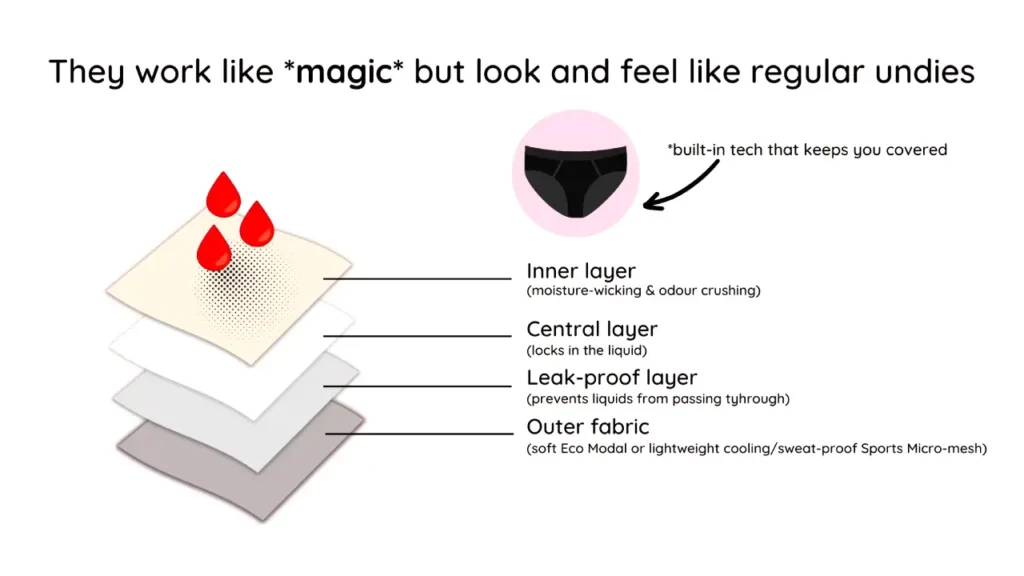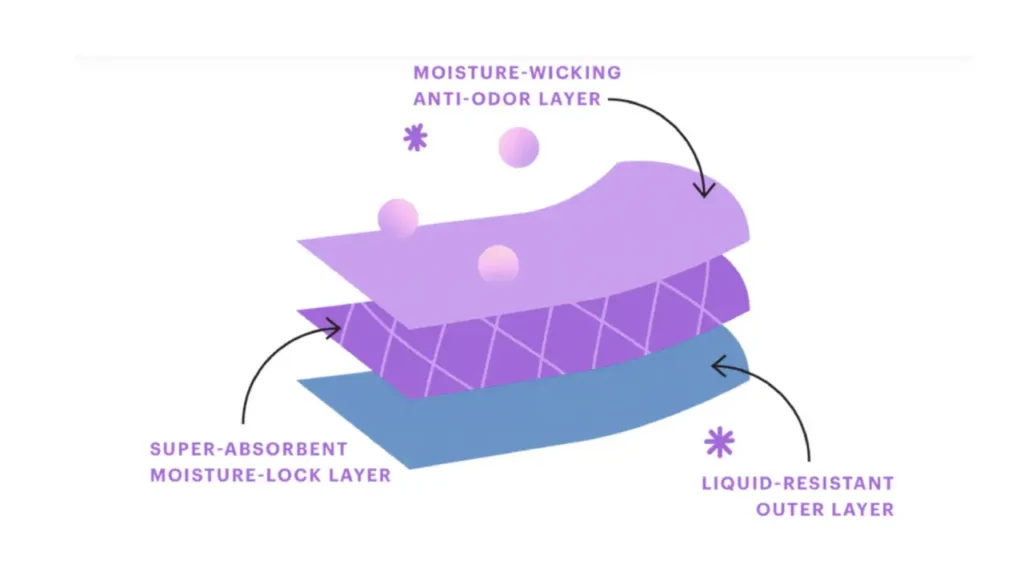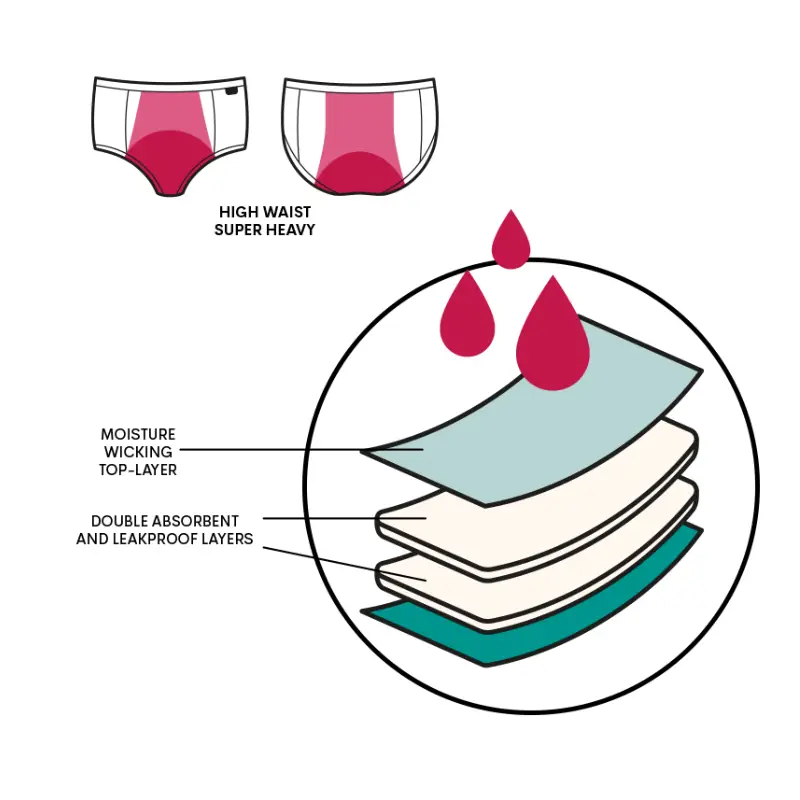Curious about the magic behind period underwear? These innovative garments have gained popularity as a comfortable and sustainable alternative to traditional period products. But how exactly do they work? It’s not just regular underwear with extra padding. Period underwear utilizes layers of specialized fabrics designed to absorb and trap menstrual flow, keeping you feeling dry and secure throughout your day.
Understanding the technology and design behind period underwear can help you make an informed decision about whether they’re the right choice for you. From moisture-wicking inner layers to super-absorbent cores and leak-proof outer barriers, each component plays a crucial role in providing reliable protection and comfort during your menstrual cycle. Let’s dive into the fascinating science of how period underwear works.
What is Period Underwear

Period underwear is a specially designed type of reusable underwear that incorporates absorbent layers directly into the gusset. These layers are engineered to soak up menstrual blood, providing a leak-proof alternative to disposable pads and tampons. The inner layers often feature moisture-wicking fabrics to keep the wearer feeling dry, while the core absorbent layers trap and hold the fluid. A final, leak-resistant outer layer prevents any breakthrough onto clothing.
This innovative product offers a convenient and environmentally friendly way to manage menstruation. Available in various styles and absorbency levels, period underwear can be worn on its own for light to moderate flow or as a backup for heavier days or when using other menstrual products. They are designed to be comfortable, discreet, and washable, making them a sustainable and cost-effective option over time.
How Does Period Underwear Work

Considering a switch to period underwear might leave you wondering about the technology behind this absorbent garment. How can regular-looking underwear effectively manage menstrual flow? The secret lies in the intelligent layering of specialized fabrics, each playing a crucial role in wicking, absorbing, and preventing leaks.
Understanding these layers will illuminate how period underwear provides a comfortable and reliable alternative to traditional period products.
The Moisture-Wicking Top Layer
The layer of period underwear closest to your skin is engineered with moisture-wicking properties. Typically made from fabrics like cotton, bamboo, or specialized synthetic blends, this layer’s primary function is to quickly draw menstrual fluid away from the surface.
This rapid absorption helps you maintain a dry and comfortable feel, preventing that unpleasant dampness often associated with traditional period products. By efficiently moving moisture downwards, this top layer also aids in reducing odor and minimizing skin irritation, contributing to a more hygienic experience throughout your period.
Furthermore, the softness of this top layer is a key consideration for comfort. Since it’s in direct contact with a sensitive area, manufacturers prioritize gentle and breathable materials. This ensures that wearing period underwear feels no different from wearing regular underwear, eliminating the bulkiness or discomfort that can sometimes come with disposable pads. The focus on skin-friendly fabrics makes period underwear a viable option even for those with sensitivities.
The Absorbent Core Layers
Beneath the moisture-wicking top layer reside one or more absorbent core layers. These are the heart of the period underwear’s functionality, designed to trap and hold menstrual blood effectively. The materials used in these layers are often highly absorbent, such as cotton fleece, bamboo fleece, or microfiber blends. The number and thickness of these layers determine the overall absorbency capacity of the underwear, allowing for different levels of protection to suit various flow intensities, from light spotting to heavy flow days.
The strategic placement and construction of these core layers ensure that the absorbed fluid is distributed evenly, maximizing the underwear’s capacity and preventing localized saturation that could lead to leaks.
Some period underwear even incorporates different types of absorbent materials within these layers to optimize both rapid absorption and long-term retention. This multi-layered approach provides reliable protection throughout the day or night, depending on the absorbency level chosen.
The Leak-Proof Outer Layer
The final crucial component of period underwear is the leak-proof outer layer. This layer is typically made from a thin, flexible, and breathable waterproof material, such as polyurethane laminate (PUL).
Its primary function is to prevent any absorbed menstrual fluid from passing through the underwear and staining your clothing. While providing this essential barrier, the breathability of the material is also important to prevent a hot and sweaty feeling, ensuring comfort throughout wear.
The careful construction and sealing of this outer layer, often extending up the front and back of the underwear, provide confidence and security against leaks in various positions and during different activities.
This leak-proof technology allows you to go about your day without the constant worry of accidents, offering a reliable and discreet alternative to traditional period products. The integration of this layer into the overall design ensures that the underwear remains comfortable and doesn’t feel bulky or restrictive.
How Do Knix Period Underwear Work

Curious about how Knix period underwear offers such reliable protection without the bulk of traditional pads? The magic lies in their innovative layering system, meticulously designed to keep you dry and confident throughout your cycle.
Understanding the technology behind Knix can help you appreciate how these garments effectively manage menstrual flow and provide a comfortable alternative to disposable products.
The Multi-Layered System
Knix period underwear, like most brands, utilizes a multi-layered system within the gusset to effectively manage menstrual flow. The innermost layer, closest to your skin, is designed for comfort and quick wicking of moisture. This layer draws the fluid away from the surface, helping you feel dry and preventing irritation.
Beneath this lies the core absorbent layer(s), which are made from materials specifically chosen for their ability to soak up and retain liquid. The number and type of these layers determine the absorbency level of the underwear, ranging from light for spotting to ultra-heavy for maximum protection. Finally, the outermost layer is a leak-proof barrier, preventing any absorbed fluid from passing through and staining your clothes, providing peace of mind throughout your day or night.
Targeted Absorbency and Odor Control
Knix often incorporates specific technologies and materials to enhance the performance of their period underwear. For instance, they may use fabrics with antimicrobial properties to help control odor. The design of the absorbent layers is also carefully considered to provide targeted protection where it’s needed most.
Some Knix styles feature extended absorbent zones for extra coverage, particularly for overnight use or heavier flows. The overall goal is to create a garment that feels like regular underwear but offers superior protection and comfort during your period.
Variety of Styles and Absorbency Levels
Knix offers a diverse range of period underwear styles to suit different preferences and needs, from bikinis and briefs to high-waisted and thong options. Each style is available in various absorbency levels, clearly indicated to help you choose the right pair for your flow.
This variety ensures that you can find Knix period underwear that fits comfortably, matches your personal style, and provides the appropriate level of protection for each day of your cycle, whether you need light back-up or complete replacement for disposable products.
How to Get Period Blood Stains Out of Underwear

Dealing with period blood stains on your favorite underwear is a common occurrence, but with the right approach, you can often lift these stains effectively. The key is to act quickly and utilize cold water to prevent the stain from setting.
By following these simple steps and using readily available household items or targeted stain removers, you can increase the chances of restoring your underwear to its former glory.
Rinse Immediately with Cold Water
The very first thing you should do when you notice a period blood stain on your underwear is to rinse it thoroughly with cold water. This is the most crucial step, as cold water helps to lift the fresh blood from the fabric fibers without causing it to coagulate and set, which hot water would do.
Run the stained area under a cold tap, gently rubbing the fabric to encourage the blood to wash away. Continue rinsing until the water runs clear, indicating that most of the blood has been removed.
Pretreat with Stain Remover or Household Solutions
After the initial cold water rinse, apply a stain remover specifically formulated for blood or protein-based stains directly to the affected area. Follow the product instructions for application and soaking time. If you don’t have a specialized stain remover on hand, several household alternatives can also be effective.
Hydrogen peroxide can help to break down blood stains (use with caution on colored fabrics as it may cause bleaching). Another option is to create a paste of baking soda and cold water and apply it to the stain, allowing it to sit for several hours before rinsing.
Wash in Cold Water and Air Dry
Once you’ve pretreated the stain, wash your underwear in the washing machine using cold water on a gentle cycle. Again, avoid hot water as it can set any remaining blood. Use a mild detergent and ensure the stain has been completely removed before drying.
It’s best to air dry your underwear after treatment, as the heat from a dryer can make any residual stain more difficult to remove. If the stain persists after washing and air drying, repeat the pretreatment process and wash again.
How Much Blood Can Period Underwear Hold
The amount of blood period underwear can hold varies significantly depending on the brand, style, and absorbency level. Generally, they are designed to hold anywhere from a small amount, suitable for spotting or light flow (around 5 ml, equivalent to about half a tampon or a panty liner), up to a substantial amount meant for heavy flow or overnight wear (some claim to hold up to 50 ml or more, equivalent to around 4-5 regular tampons or pads).
Many brands offer different tiers of absorbency, such as light, moderate, heavy, and super, each with a corresponding capacity often described in terms of how many tampons or pads worth of fluid they can hold.
It’s important to check the specific product details provided by the manufacturer to understand the absorbency level you are choosing. Factors like the thickness and composition of the absorbent core layers contribute to the overall capacity of the underwear.
Here’s a general idea of absorbency levels:
- Light: Designed for spotting, discharge, or as backup; holds a small amount, similar to a panty liner or a light tampon.
- Moderate: Suitable for light to regular flow days; can hold the equivalent of 1-2 regular tampons or pads.
- Heavy: Intended for heavier flow days; can hold the equivalent of 2-3 regular tampons or pads.
- Super/Overnight: Designed for the heaviest flow or overnight wear; can hold the equivalent of 4-5 or more regular tampons or pads.
Why is My Underwear Brown but No Period
It’s understandable to be concerned when you notice brown discharge in your underwear, especially when you’re not expecting your period. The brown color typically indicates the presence of old blood that has had time to oxidize. This can happen for a variety of reasons, and while it’s often normal, it can sometimes signal an underlying issue.
One of the most common reasons for brown discharge without a period is simply that it’s the tail end of your last period. Sometimes, the flow slows down significantly at the end, and the remaining blood takes longer to exit the body, giving it that brown appearance as it oxidizes. Similarly, you might experience a bit of brown discharge just before your period is due to start, as the flow begins very lightly. Ovulation can also cause mid-cycle spotting that appears brown.
However, brown discharge without a period can also be related to other factors. Hormonal fluctuations, especially when starting or changing birth control, can lead to spotting. In early pregnancy, implantation bleeding, which occurs when the fertilized egg implants in the uterine lining, can sometimes be brown. Less commonly, brown discharge could be a sign of an infection, such as bacterial vaginosis or a sexually transmitted infection, or even a benign growth like a polyp. In rare cases, it can be a symptom of more serious conditions.
Here are some potential reasons why you might have brown discharge without your period:
- End of period: Residual old blood leaving the uterus.
- Beginning of period: Very light initial flow.
- Ovulation: Mid-cycle spotting.
- Hormonal changes: Starting or changing birth control.
- Implantation bleeding: Early sign of pregnancy.
- Irritation: From intercourse or vaginal exams.
- Infections: Such as bacterial vaginosis or STIs.
- Benign growths: Like polyps or fibroids.
- Perimenopause: Hormonal shifts leading up to menopause.
- Retained foreign object: Like a forgotten tampon.
If you are concerned about the brown discharge, especially if it has an odor, is accompanied by pain or itching, or if it’s persistent, it’s always best to consult with a healthcare professional to determine the underlying cause and rule out any potential medical issues.
Why Do My Period Underwear Smell Like Ammonia
The smell of ammonia in your period underwear can be a sign of a few different things, most of which are easily addressed. One common reason is the breakdown of urea, a compound found in both sweat and urine. Even small amounts of urine leakage, which can happen unintentionally, especially during exercise or if you don’t wipe thoroughly, can leave traces of urea on the fabric. When this mixes with sweat and bacteria, it can produce an ammonia-like odor. Additionally, dehydration can concentrate the urea in your urine, making any small leaks more noticeable as an ammonia smell.
Another contributing factor can be related to how your period products interact with bodily fluids. Menstrual blood itself doesn’t typically smell like ammonia, but when it mixes with other vaginal fluids, sweat, and potentially small amounts of urine, the bacteria present can break down these components, leading to odor. If your period underwear isn’t being rinsed and washed promptly and thoroughly, this build-up of fluids and bacteria can contribute to the ammonia smell.
Here are some potential reasons why your period underwear might smell like ammonia:
- Residual Urine: Even small, unnoticeable leaks can leave urea.
- Dehydration: Concentrated urine has a stronger ammonia scent.
- Sweat: The groin area has many sweat glands, and sweat contains urea.
- Bacterial Breakdown: Bacteria on your skin and in vaginal fluids can break down urea and other compounds.
- Inadequate Washing: Not rinsing and washing period underwear promptly and thoroughly can lead to odor build-up.
- Type of Detergent: Some detergents might not be effectively removing all residues.
- Long Wear Times: Wearing period underwear for extended periods without changing, especially on heavier flow days, can contribute to odor.
Conclusion
In essence, period underwear employs a clever multi-layered system to effectively manage menstrual flow, offering a comfortable, reliable, and eco-conscious alternative to traditional products. By wicking away moisture, absorbing fluids, and preventing leaks, they provide a sense of security and freedom during your period. Understanding this technology empowers you to make an informed choice for your menstrual health and the planet.
Looking to provide your customers with this innovative and sustainable period solution? We offer a wide selection of wholesale period underwear, catering to diverse needs and preferences.
Partner with us to meet the growing demand for comfortable and eco-friendly period care. Explore our wholesale options now and offer your customers a better period experience!

